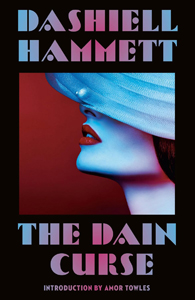Dashiell Hammett’s five novels suggest that his writing career went in reverse. He did two experimental novels first – the almost stream-of-consciousness plotting of “Red Harvest” (1929) and the equally complex but more structured “The Dain Curse” (1929) (which I’ll review here).
Then his 1930s books “The Maltese Falcon,” “The Glass Key” and “The Thin Man” are recognizable as hardboiled detective stories with no excess fat on them. Although at the time they were groundbreaking (so they are “experimental” in that sense), a re-read shows them to be more straightforward than Hammett’s first two books.
‘Thinking is a dizzy business’
“The Dain Curse” features three mysteries, split into three parts in the novel (the latter part had been split in two for the magazine serialization): “The Dains,” “The Temple” and “Quesada.” At the end of the final part, the Continental Op explains to the reader how these three mysteries are linked together under a puppet master.

“The Dain Curse” (1929)
Author: Dashiell Hammett
Genre: Hardboiled mystery
Series: The Continental Op
Setting: 1929, San Francisco and surrounding area
The novel is incredibly ambitious, and there probably isn’t a reader on the planet who could give you a brief synopsis. A rollercoaster of plotting it may be, but “The Dain Curse” is also a thoroughly enjoyable read.
Whereas the Op uses his fists and weapons to solve many problems in “Red Harvest,” in this follow-up he moves from that book’s rough mountain town to his home base of San Francisco and is more likely to use his brains. A reader could almost think he’s a new character, but before long I saw him as a versatile character. He gives each case the treatment it asks for, like a top-shelf operative should.
As complex as the plot is, and as large as the character roster is, “The Dain Curse” breathes the most of any Hammett novel, with the Op – often a loner – regularly shooting the breeze with an old friend, the quirky novelist Fitzstephan.
‘Lies are worthless, and only lies would help’
While most of the prose is hardboiled, Hammett occasionally opens up into Chandler-esque similes, like when he describes Gabrielle as being as content as a cat with a belly full of goldfish. A more bizarre type of humor comes when Hammett types out a long paragraph of a gambler counting out his winnings, showing off for the Op. This passage also illustrates the Op’s level of patience.
Another example of his methodical patience comes later: “Twenty minutes of the sheriff’s conversation didn’t add anything to my education.” Modesty and hard-earned intelligence are other understated traits of the Op. For example, he knows exactly how to wean Gabrielle off of her morphine addiction.

Gabrielle – an unstable 20-something who believes she has a Dain family curse wherein bad things happen around her — might be seen as an even wilder version of the femme fatale in “The Maltese Falcon.” She features in all the events and maybe is a victim, maybe is a villain.
Part one features a diamond heist (the agency is hired by the insurance company) and ends with a murderer being found out – maybe. The suspect commits suicide at the end, and – in a reflection of how this would work in real life – the case is closed from the agency’s perspective.
Indeed, many real-world cases close in unsatisfying fashion, with loose ends. But this being fiction, Hammett bails us out with part two, wherein the Op is hired by the estate’s executor to keep an eye on the morphine-addicted Gabrielle, who has fallen in with a cult.
‘It got done’
Just as Agatha Christie skirted the edge of the supernatural, Hammett flirts with the genre in a smoke-and-mirrors segment that might’ve had the “Scooby Doo” writers taking notes decades later. Part three then expands the canvas to Quesada, which the author describes as one of the sleepiest California coastal towns, for one more murder investigation connected to Gabrielle.
As wild as the case is, the Op’s meat-and-potatoes detective work and thoughtful analysis win the day. This stands in contrast to novelist Fitzstephan’s imaginative leaps. In this way, Hammett goes meta and comments on how detective work really is versus how it’s portrayed in fiction.
“The Dain Curse” is nonetheless the most wildly plotted of Hammett’s five novels. It’s not talked about to the degree of the other four. That makes sense: “Red Harvest” was influential on “cleaning up the town” political and mob movies, plus Hammett’s own more tightly plotted “The Glass Key.” “The Maltese Falcon” defined hardboiled detective fiction, and then the franchise-launching “The Thin Man” gave us a softer-boiled version with the Charleses’ fun spousal banter.
“The Dain Curse” (not quite the last Op tale, as a few more short stories followed) is the outlier, being shorter on thematic resonance and genre influence. Like all Hammett novels, a close read is required. That’s not a problem, because it’s easy to soak up the words like a sponge. But don’t be scared off by reports that the novel is hard to follow; the reader must simply be as dedicated as the Op is.
Sleuthing Sunday reviews the works of Agatha Christie, along with other new and old classics of the mystery genre.

